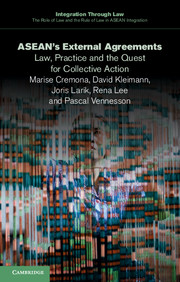Book contents
- Frontmatter
- Contents
- List of tables
- List of charts
- General editors' preface
- 1 Introduction
- 2 The legal and institutional framework for ASEAN external agreements: the centrality of ASEAN
- 3 An inventory and typology of ASEAN external instruments: overview and trends
- 4 ASEAN as a contracting party
- 5 Beyond market access? The anatomy of ASEAN's preferential trade agreements
- 6 A regional strategy: a typology of ASEAN partnership and co-operation agreements
- 7 Between great-power rivalries and supranationality: ASEAN external instruments and regional hedging strategies
- Executive summary
- Appendices
- Index
Executive summary
Published online by Cambridge University Press: 05 May 2015
- Frontmatter
- Contents
- List of tables
- List of charts
- General editors' preface
- 1 Introduction
- 2 The legal and institutional framework for ASEAN external agreements: the centrality of ASEAN
- 3 An inventory and typology of ASEAN external instruments: overview and trends
- 4 ASEAN as a contracting party
- 5 Beyond market access? The anatomy of ASEAN's preferential trade agreements
- 6 A regional strategy: a typology of ASEAN partnership and co-operation agreements
- 7 Between great-power rivalries and supranationality: ASEAN external instruments and regional hedging strategies
- Executive summary
- Appendices
- Index
Summary
The Association of Southeast Asian Nations (ASEAN), apart from being a regional integration project for its member states, also exhibits an ambition to play a role on the global stage. The ASEAN Charter, which was signed in 2007 and entered into force the year after, posits as one of the purposes of the Association ‘[t]o maintain the centrality and proactive role of ASEAN as the primary driving force in its relations and cooperation with its external partners in a regional architecture that is open, transparent and inclusive’. Further-more, ASEAN itself has been accorded the express power to ‘conclude agreements with countries or sub-regional, regional and international organisations and institutions’. The stage is thus set, in legal terms, for ASEAN as an emerging global player.
And indeed a rapidly increasing number of international legal and other instruments carry the name ‘ASEAN’ and/or involve all the member states together. The term ‘collectively ASEAN’ is the hallmark of ASEAN's formalised relations with its external partners. No fewer than 175 instruments, including international agreements, memoranda of understanding, plans of action and declarations, exist today, covering the fields of economic, security, political and socio-cultural co-operation, and 81 per cent of these have been concluded or issued since the year 2000. Although there is undoubtedly a wide variation in the legal and political significance of these instruments, the overall level of external activity is considerable and growing.
This study presents the first comprehensive legal– political analysis of these 175 instruments. More specifically, we organise the existing stock of instruments into an inventory and typology, organised in terms of legal quality (bindingness), time, content, contracting party on the ASEAN side and external partners. The objective is to provide a macro- rather than a micro-analysis of ASEAN external instruments, to establish criteria in order to create a typology and enable us to address the following main questions: what is the legal quality of the different types of ASEAN external instrument? What exactly is an ‘ASEAN external agreement’?
- Type
- Chapter
- Information
- ASEAN's External AgreementsLaw, Practice and the Quest for Collective Action, pp. 297 - 310Publisher: Cambridge University PressPrint publication year: 2015



